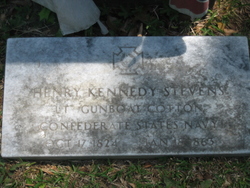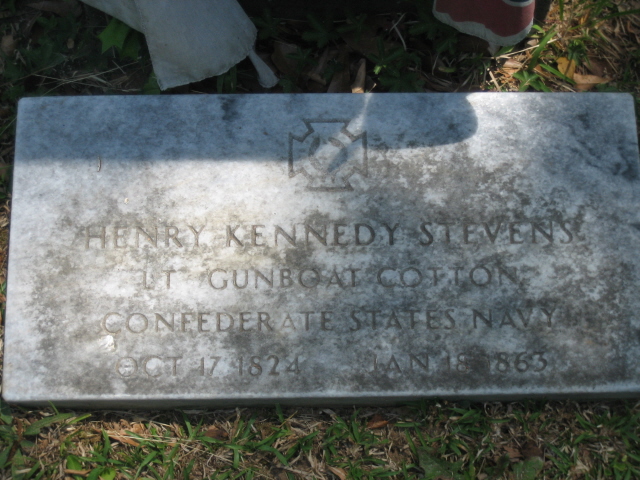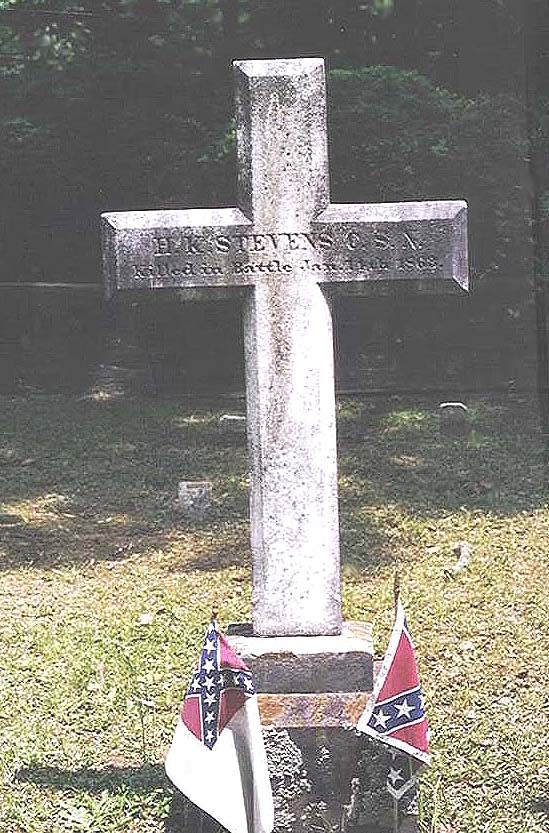He was the brother of Confederate Brig. General Clement H. Stevens.
He was the first cousin of Confederate Brig. Generals Barnard E. Bee Jr. and Hamilton P. Bee.
On October 28, 1858 as Lieutenant H.K. Stevens, he married Grace Totten, daughter of Joseph G. Totten at New Haven, Connecticut.
It appears his widow, Grace Totten Stevens remarried.
Per New Jersey, U.S., Marriage Records, 1670-1965 On May 20, 1873 as Elizabeth Grace Stevens, Widow, aged 50, she married Charles Hinman Graves at Morris, New Jersey.
Her parents were listed as Joseph Gilbert Totten and C. Totten.
On the 1900 Census for Duluth, Saint Louis County, Minnesota, she lists -0- children born, -0- children living.
A young, ardent and skilled U.S. Naval officer he refused to take the oath of allegiance when the U.S. Constellation arrived at Portsmouth Navy Yard in 1861. Held on the frigate Congress off Newport News he was dismissed from the U.S.N. in September 1861. He was exchanged for Federal Lieutenant Albert Kautz in November 1861. On December 7, 1861 he was appointed a First Lieutenant in the Confederate States Navy. His first posting was as the Executive Officer of the Confederate ram C.S.S. Arkansas. In "The Story of the Arkansas," Stevens was characterized as a conscientious Christian gentleman, a zealous and effective officer. In the performance of his duty he was thorough, consistent and patriotic. His courage was of the truest and highest type; in the face of the enemy he knew nothing but his duty, and always did it."
The C.S.S. Arkansas was lost in early August 1862 after she left Vicksburg to support a Confederate attempt to recapture Baton Rouge. Lt. Stevens had been in command since July as her captain had became ill. After her engines broke down three times on the way to Vicksburg, Lt. Stevens gave the order to destroy her as U.S.N. ships approached. The ship was set afire with all her guns loaded, the moorings were cut and she was set adrift. Lt. Stevens was quoted as saying with tears in his eyes, "It was beautiful to see her, when abandoned by commander and crew, and dedicated to sacrifice, fighting the battle alone." The C.S.S. Arkansas achieved a combat record matched by few other Confederate warships. The modern day hunt for the wreck of the C.S.S. Arkansas is chronicled in "The Sea Hunters" by Clive Cussler along with an account of the action that resulted in her loss.
In December 1862 Lt. Stevens was ordered to take charge of all naval forces in the waters in Louisiana. At Bayou Teche the steamer J.A. Cotton was attacked from the shore by Union troops and from the bayou by Union gunboats. Lt. Stevens was killed on deck by two balls that pierced his chest. Northern news accounts called it "The Battle of Corney's Bridge" and recounted how Gen. Godfrey Weitzel had gone up the bayou to destroy a rebel boat called the Cotton.
He was the brother of Confederate Brig. General Clement H. Stevens.
He was the first cousin of Confederate Brig. Generals Barnard E. Bee Jr. and Hamilton P. Bee.
On October 28, 1858 as Lieutenant H.K. Stevens, he married Grace Totten, daughter of Joseph G. Totten at New Haven, Connecticut.
It appears his widow, Grace Totten Stevens remarried.
Per New Jersey, U.S., Marriage Records, 1670-1965 On May 20, 1873 as Elizabeth Grace Stevens, Widow, aged 50, she married Charles Hinman Graves at Morris, New Jersey.
Her parents were listed as Joseph Gilbert Totten and C. Totten.
On the 1900 Census for Duluth, Saint Louis County, Minnesota, she lists -0- children born, -0- children living.
A young, ardent and skilled U.S. Naval officer he refused to take the oath of allegiance when the U.S. Constellation arrived at Portsmouth Navy Yard in 1861. Held on the frigate Congress off Newport News he was dismissed from the U.S.N. in September 1861. He was exchanged for Federal Lieutenant Albert Kautz in November 1861. On December 7, 1861 he was appointed a First Lieutenant in the Confederate States Navy. His first posting was as the Executive Officer of the Confederate ram C.S.S. Arkansas. In "The Story of the Arkansas," Stevens was characterized as a conscientious Christian gentleman, a zealous and effective officer. In the performance of his duty he was thorough, consistent and patriotic. His courage was of the truest and highest type; in the face of the enemy he knew nothing but his duty, and always did it."
The C.S.S. Arkansas was lost in early August 1862 after she left Vicksburg to support a Confederate attempt to recapture Baton Rouge. Lt. Stevens had been in command since July as her captain had became ill. After her engines broke down three times on the way to Vicksburg, Lt. Stevens gave the order to destroy her as U.S.N. ships approached. The ship was set afire with all her guns loaded, the moorings were cut and she was set adrift. Lt. Stevens was quoted as saying with tears in his eyes, "It was beautiful to see her, when abandoned by commander and crew, and dedicated to sacrifice, fighting the battle alone." The C.S.S. Arkansas achieved a combat record matched by few other Confederate warships. The modern day hunt for the wreck of the C.S.S. Arkansas is chronicled in "The Sea Hunters" by Clive Cussler along with an account of the action that resulted in her loss.
In December 1862 Lt. Stevens was ordered to take charge of all naval forces in the waters in Louisiana. At Bayou Teche the steamer J.A. Cotton was attacked from the shore by Union troops and from the bayou by Union gunboats. Lt. Stevens was killed on deck by two balls that pierced his chest. Northern news accounts called it "The Battle of Corney's Bridge" and recounted how Gen. Godfrey Weitzel had gone up the bayou to destroy a rebel boat called the Cotton.
Family Members
Advertisement
Records on Ancestry
Sponsored by Ancestry
Advertisement









